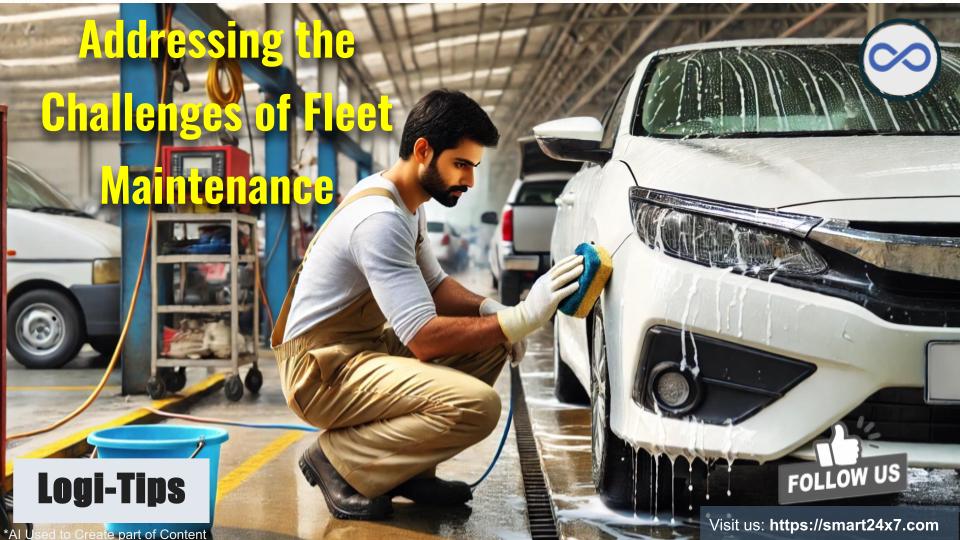Effective fleet maintenance is crucial for ensuring the smooth operation, safety, and longevity of vehicles in any transport business. However, managing a fleet’s maintenance can be complex and challenging. Transport heads and procurement managers must navigate various issues, from maintenance costs to regulatory compliance. At Smart24x7, our advanced transport management system provides comprehensive solutions to address these challenges and optimize fleet maintenance. Here’s how.
1. High Maintenance Costs
Cost Management Strategies:
- Preventive Maintenance Programs: Implement preventive maintenance schedules to catch and fix minor issues before they become costly repairs.
- Bulk Purchasing Agreements: Negotiate bulk purchasing agreements for parts and services to reduce maintenance costs.
- Predictive Maintenance: Use data analytics to predict and address potential issues before they escalate, reducing unexpected repair costs.
Leveraging Technology:
- Telematics Integration: Utilize telematics to monitor vehicle health and performance in real-time, enabling timely maintenance interventions.
- Automated Maintenance Alerts: Set up automated alerts for scheduled maintenance tasks, ensuring timely service and reducing the risk of costly breakdowns.
2. Downtime and Vehicle Availability
Minimizing Downtime:
- Efficient Scheduling: Plan maintenance during off-peak hours to minimize the impact on vehicle availability.
- Spare Vehicles: Maintain a pool of spare vehicles to cover those undergoing fleet maintenance, ensuring continuous operations.
Rapid Response Systems:
- Mobile Maintenance Units: Deploy mobile maintenance units for on-site repairs, reducing downtime caused by sending vehicles to workshops.
- Quick-Response Teams: Establish quick-response teams to address urgent maintenance issues promptly.
3. Managing a Diverse Fleet
Customized Maintenance Plans:
- Vehicle-Specific Schedules: Develop maintenance schedules tailored to the specific needs of different vehicle types in the fleet.
- Standardized Procedures: Implement standardized maintenance procedures across all vehicle types to ensure consistency and efficiency.
Data-Driven Decisions:
- Comprehensive Analytics: Use data analytics to track performance metrics and maintenance needs for each vehicle type.
- Inventory Management: Maintain an organized inventory of parts and tools needed for different vehicles, ensuring quick and efficient maintenance.
4. Regulatory Compliance
Ensuring Compliance:
- Regular Inspections: Schedule regular inspections to ensure all vehicles meet regulatory compliance standards and avoid fines.
- Documentation and Reporting: Keep accurate records of all maintenance activities and generate reports to demonstrate compliance during audits.
Stay Updated:
- Regulatory Monitoring: Stay informed about changes in regulations and adjust maintenance practices accordingly.
- Compliance Training: Provide ongoing training for maintenance staff to ensure they are aware of and adhere to current regulatory compliance.
5. Safety and Risk Management
Enhancing Safety:
- Proactive Safety Checks: Conduct regular safety checks to identify and address potential hazards before they cause accidents.
- Driver Feedback: Encourage drivers to report any vehicle issues immediately, facilitating prompt maintenance and enhancing safety.
Risk Mitigation:
- Insurance Compliance: Ensure that all vehicles meet insurance requirements through regular fleet maintenance.
- Incident Analysis: Analyze maintenance-related incidents to identify patterns and implement preventive measures.
6. Technological Integration
Adopting Advanced Tools:
- Fleet Management Software: Use comprehensive fleet management software like Smart24x7 to manage all aspects of maintenance efficiently.
- IoT and Telematics: Integrate IoT devices and telematics to gather real-time data on vehicle health and performance.
Continuous Improvement:
- Performance Monitoring: Regularly monitor and evaluate the performance of maintenance activities to identify areas for improvement.
- Technology Upgrades: Stay abreast of the latest technological advancements and incorporate them into maintenance practices to enhance efficiency.
7. Workforce Management
Training and Development:
- Skill Enhancement: Provide regular training for maintenance staff to keep them updated on the latest techniques and technologies.
- Career Development: Create career development programs to motivate and retain skilled maintenance personnel.
Efficient Scheduling:
- Workforce Allocation: Allocate maintenance tasks based on staff expertise and availability to ensure efficient and effective maintenance.
- Shift Planning: Implement shift planning to ensure that maintenance staff is available around the clock to address urgent issues.
Addressing the challenges of fleet maintenance requires a multifaceted approach that incorporates maintenance cost management, downtime reduction, regulatory compliance, safety enhancement, technological integration, and workforce management. At Smart24x7, our advanced transport management system provides transport heads and procurement managers with the tools and insights needed to optimize fleet maintenance and ensure the smooth operation of their fleets.
Smart24x7 has been incubated by Smart Group India, demonstrating our commitment to innovation and excellence in fleet maintenance. Embrace our comprehensive solutions to tackle the challenges of fleet maintenance and achieve operational excellence with Smart24x7.
